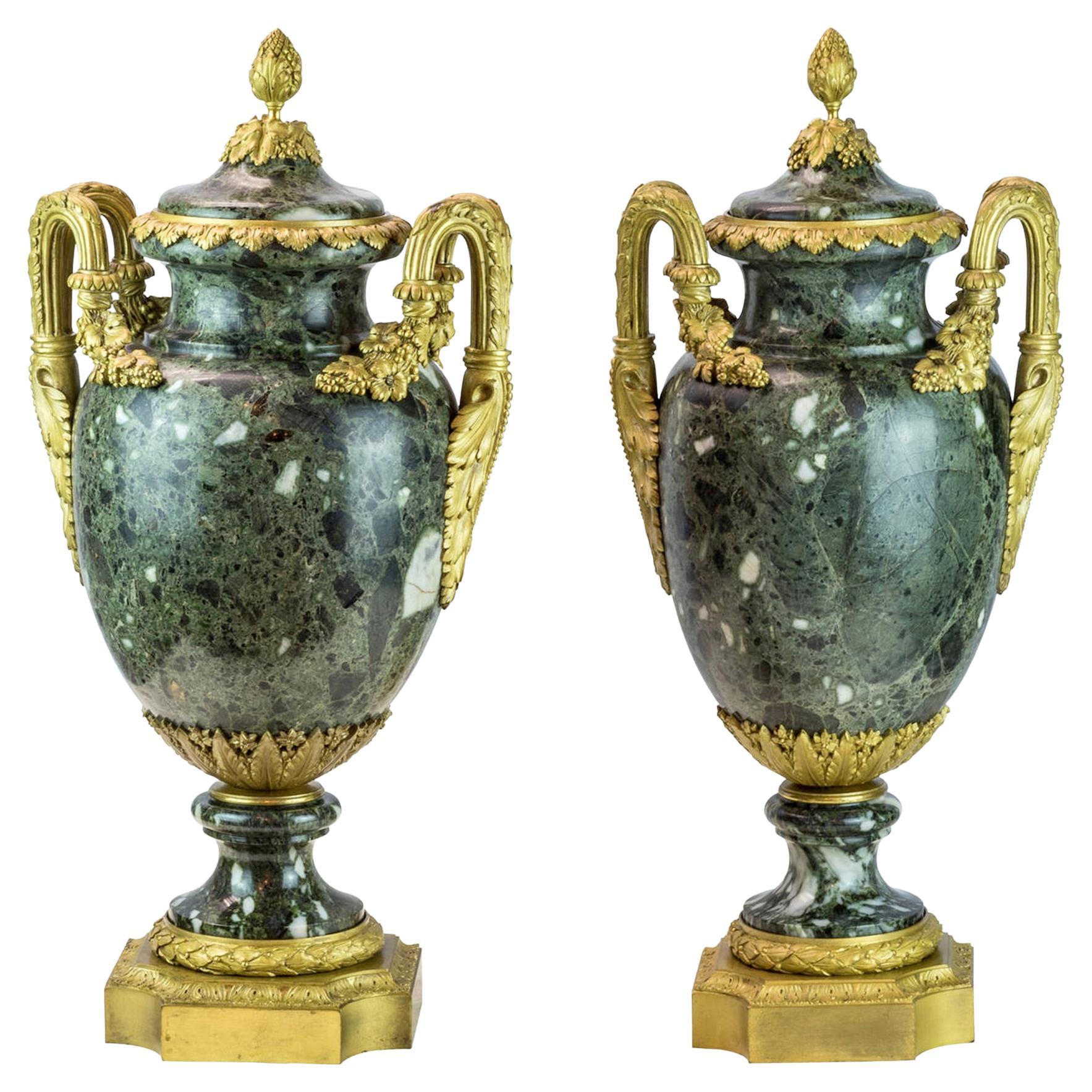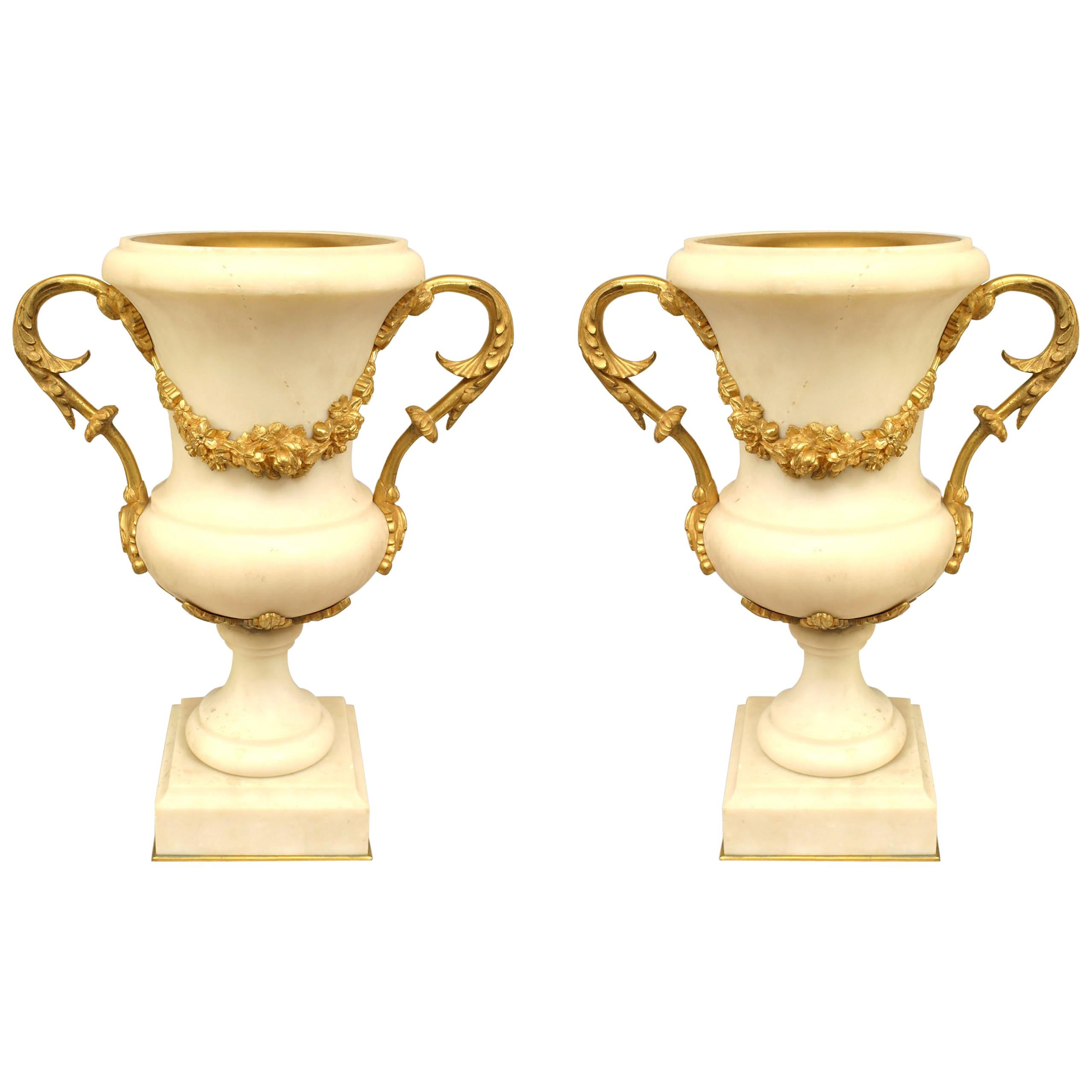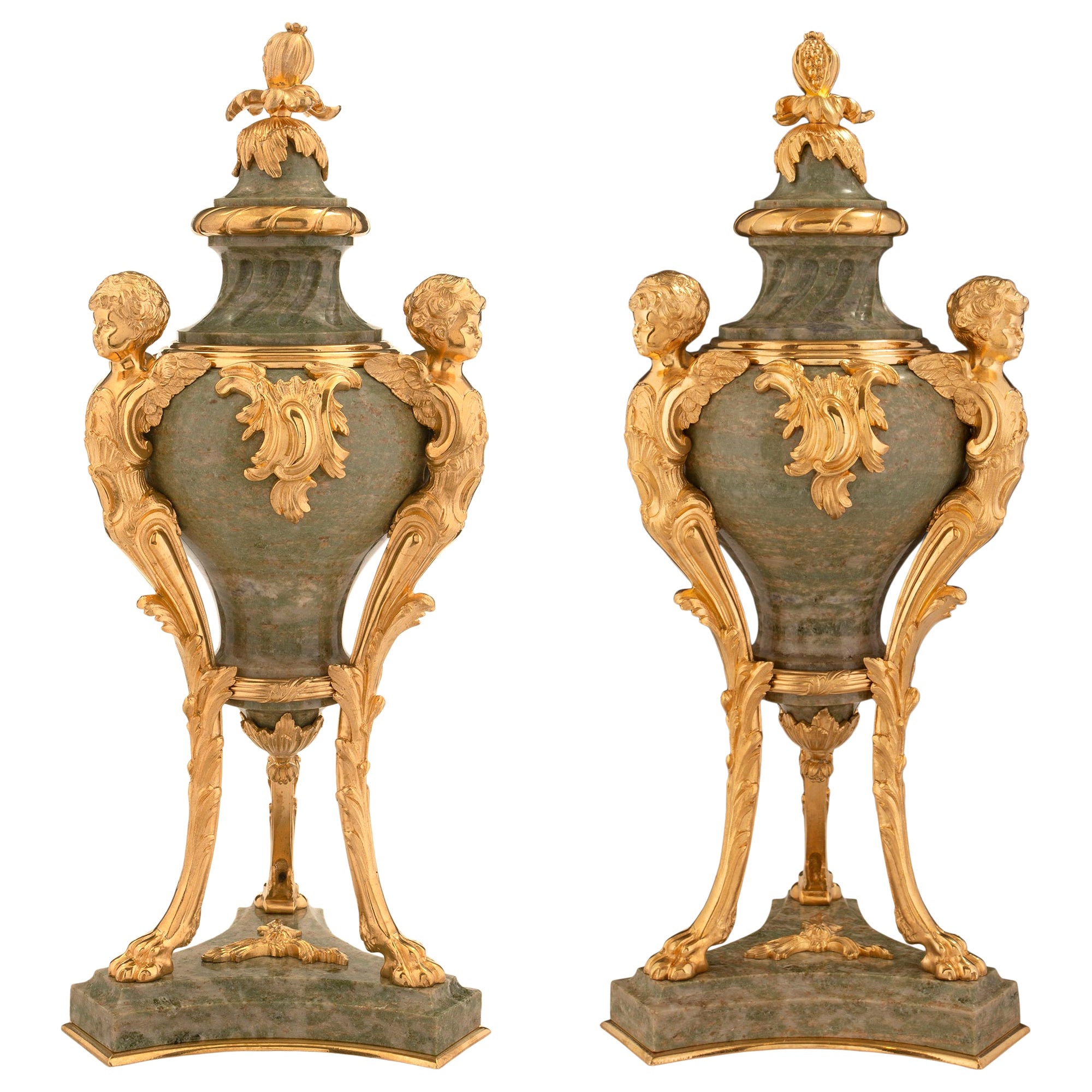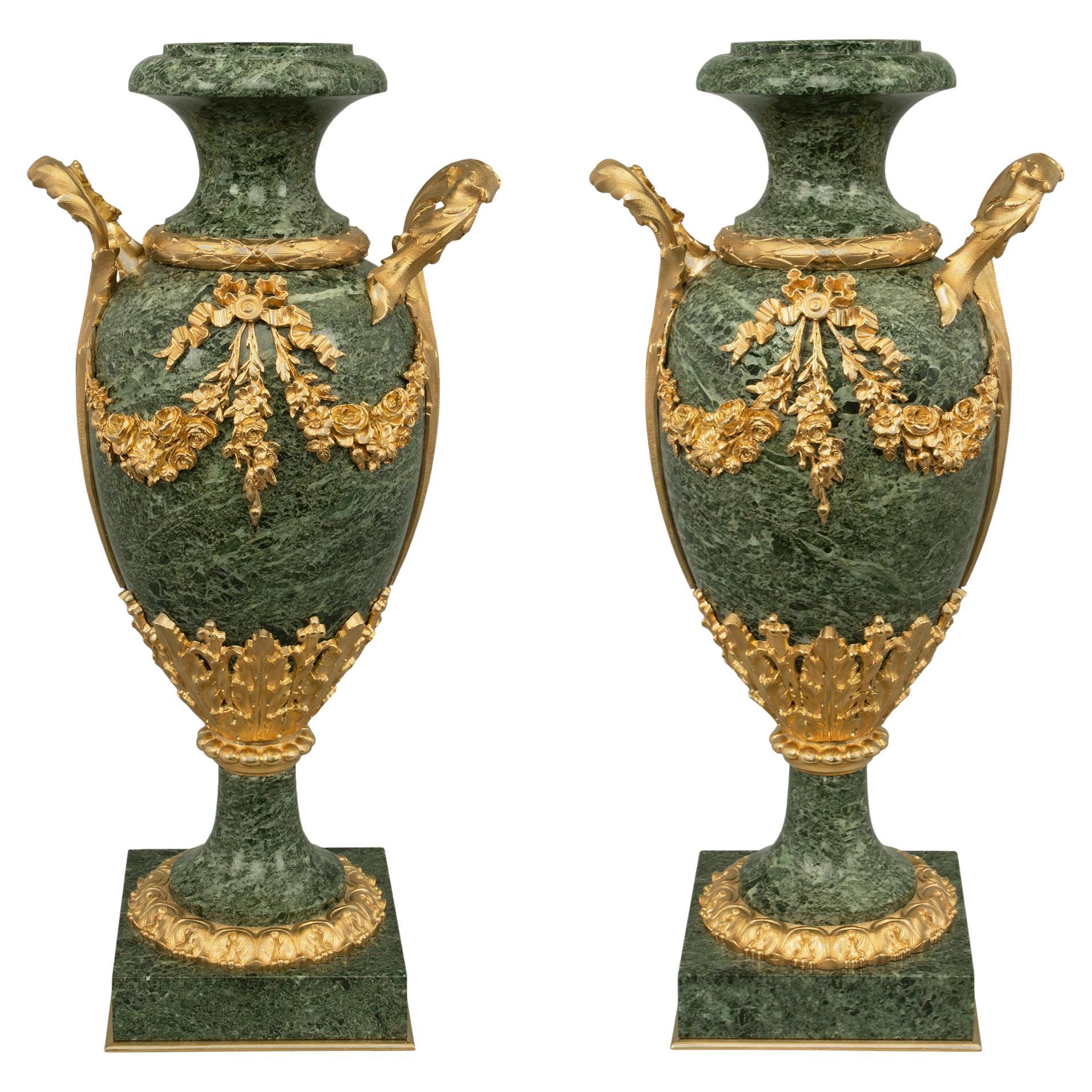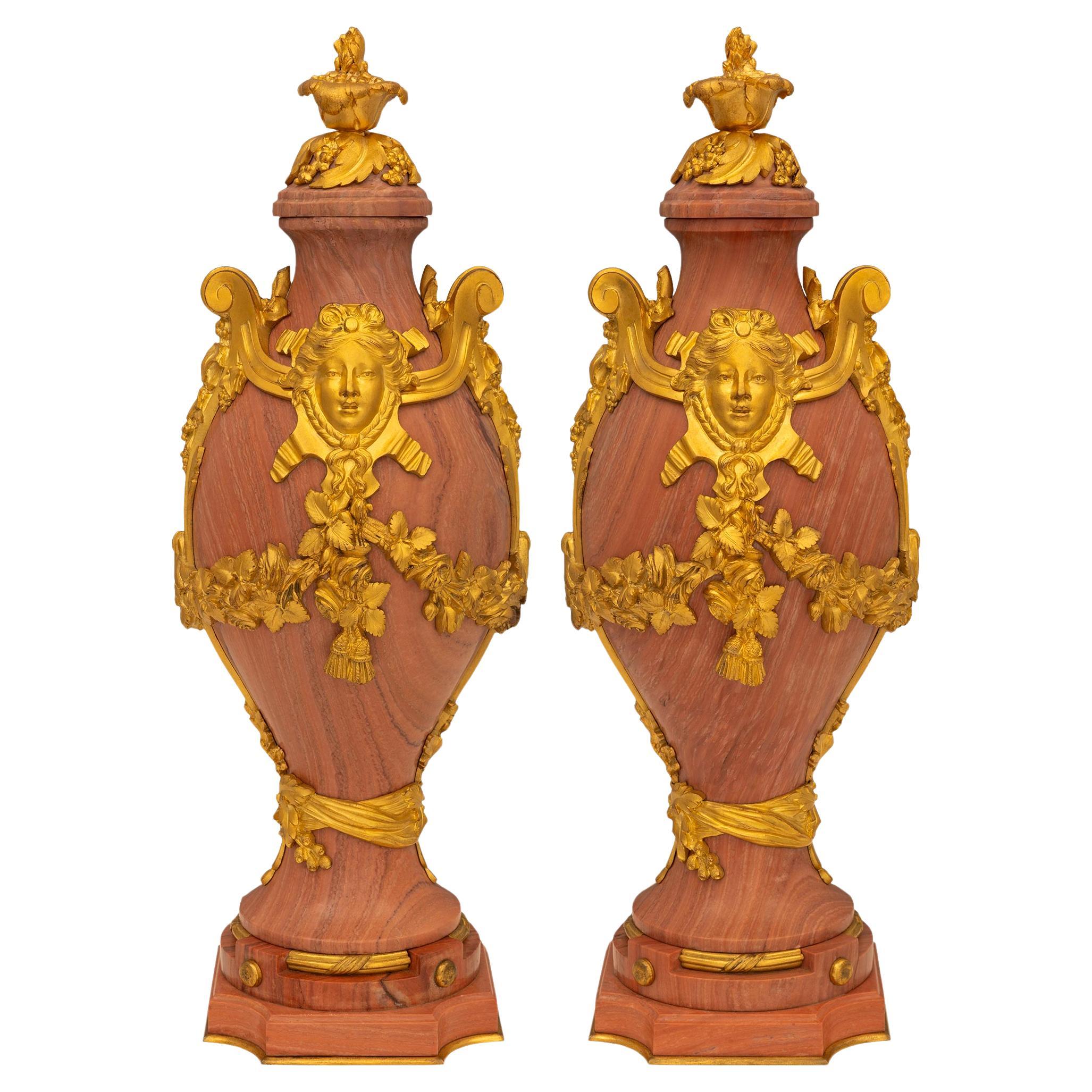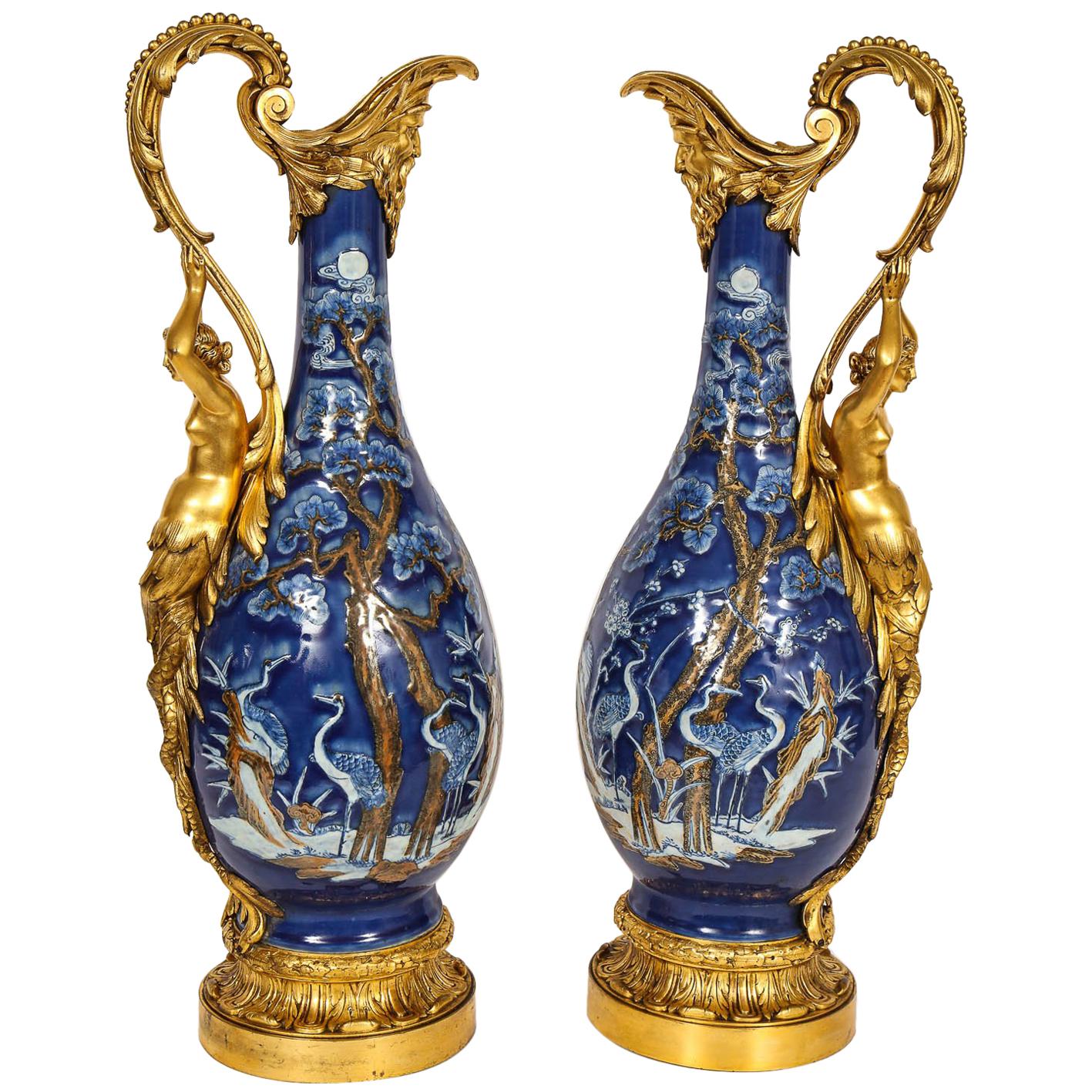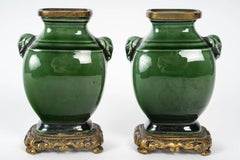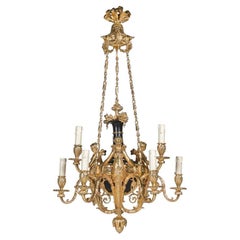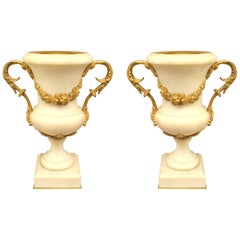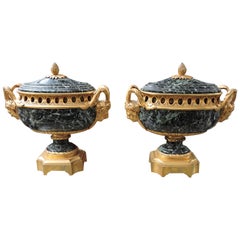
Pair of Louis XVI Style Green Marble and Ormolu Mounted Oval-Shaped, circa 1870
View Similar Items
Want more images or videos?
Request additional images or videos from the seller
1 of 7
Pair of Louis XVI Style Green Marble and Ormolu Mounted Oval-Shaped, circa 1870
About the Item
- Dimensions:Height: 9.85 in (25 cm)Width: 9.45 in (24 cm)Depth: 3.55 in (9 cm)
- Sold As:Set of 2
- Style:Louis XVI (In the Style Of)
- Materials and Techniques:
- Place of Origin:
- Period:
- Date of Manufacture:circa 1870
- Condition:Minor losses. Three chips on marble covers, One on the base, can be easily repaired.
- Seller Location:Saint-Ouen, FR
- Reference Number:1stDibs: LU261239192301
About the Seller
4.9
Vetted Seller
These experienced sellers undergo a comprehensive evaluation by our team of in-house experts.
1stDibs seller since 2017
57 sales on 1stDibs
Typical response time: 1 hour
More From This SellerView All
- Théodore Deck (1823-1891), Miniature Pair of Faience Vases circa 1870By Theodore DeckLocated in Saint-Ouen, FRTheodore Deck (1823-1891) A deep green enameled faience miniature pair of vases molded in the Chinese Archaistic Taste. Coves in the shape of elepha...Category
Antique 1870s French Chinoiserie Vases
MaterialsFaience
- Pair of Porcelain Vases Ormolu-Mounted in Lamps by Gagneau Paris XIXth CenturyBy Gagneau ParisLocated in Saint-Ouen, FRPair of large Japanese Porcelain Cone Shape Vases with Imari decoration Important mounts in ormolu and gilded metal, the base decorated with a laurel wreath, the upper part of falling leaves and a frieze of knotted ribbon. The mounts signed Gagneau, 115 R. Lafayette. Circa 1860 With their original aluminium bulb cover and original gilding Vase it self Height 47 cm The Gagneau Company is one of the most famous lighting factories in Paris in the nine-teenth century, established in 1800 at 25 rue d'Enghien in Paris and later at 115 rue de Lafayette. She has participated in many exhibitions throughout this century. She began in 1819 with the Exposition des Produits de l'Industrie and later participated in the Universal Exhibitions where she was part of the jury in the category of art bronzes (class 25) at the Universal Exhibition in Paris in 1889. "Imari" was simply the trans-shipment port for Arita wares, from where they went to the for-eign trading outposts at Nagasaki. It was the kilns at Arita which formed the heart of the Japanese porcelain industry. Arita's kilns were set up in the 17th century, after kaolin was discovered in 1616. A popular legend attributes the discovery to an immigrant Korean potter, Yi Sam-Pyeong (1579–1655), although most historians consider this doubtful. After the discovery, some kilns began to produce revised Korean-style blue and white porcelains, known as Early Imari, or "Shoki-Imari". In the mid-17th century, there were also many Chinese refugees in northern Kyushu due to the turmoil in China, and it is said that one of them brought the overglaze enamel coloring technique to Arita. Thus Shoki-Imari developed into Ko-Kutani, Imari, and later Kakiemon, which are sometimes taken as a wider group of Imari wares. Ko-Kutani was produced around 1650 for both export and domestic market.Kutani Ware is characterized by vivid green, blue, purple, yellow and red colors in bold designs of landscapes and nature. Blue and white porcelain pieces continued to be produced and they are called Ai-Kutani. Ko-Kutani Imari for the export market usually adopted Chinese design structure such as kraak style, whereas Ai-Kutani for the domestic market were highly unique in design and are ac-cordingly valued very much among collectors. Ko-Kutani style evolved into Kakiemon-style Imari, which was produced for about 50 years around 1700. Kakiemon was characterized by crisp lines, and bright blue, red and green designs of dramatically stylized floral and bird scenes. Imari achieved its technical and aes-thetic peak in the Kakiemon style, and it dominated the European market. Blue and white Kakiemon is called Ai-Kakiemon. The Kakiemon style transformed into Kinrande in the 18th century, using underglaze blue and overglaze red and gold enamels, and later additional colors. Imari began to be exported to Europe when the Chinese kilns at Jingdezhen were damaged in the political chaos and the new Qing dynasty government halted trade in 1656–1684. Ex-ports to Europe were made through the Dutch East India Company, and in Europe the des-ignation "Imari porcelain" connotes Arita wares of mostly Kinrande Imari. Export of Imari to Europe stopped in mid-18th century when China resumed export to Europe, since Imari was not able to compete against Chinese products due to high labor costs. By that time, however, both Imari and Kakiemon styles were already so popular among Eu-ropeans that the Chinese export porcelain copied both, a type known as Chinese Imari. At the same time, European kilns, such as Meissen and English potteries such as Johnson Bros. and (Royal) Crown Derby, also imitated the Imari and Kakiemon styles. Export of Imari surged again in late 19th century (Meiji era) when Japonism flourished in Europe.Thus, in the western world today, two kinds of true Japanese Imari can...Category
Antique 1880s French Japonisme Table Lamps
MaterialsBronze
- A Louis XVI Style Ormolu and Patinated 6-Light Chandelier "aux Termes"By François Rémond, Alfred Emmanuel Louis BeurdeleyLocated in Saint-Ouen, FRA very fine French Ormolu and patinated metal nine-lights figural chandelier "aux Termes" In chiseled, gilded and patinated bronze, the shaft consists of an ovoid-shaped vase in blued patinated bronze...Category
Antique 1870s French Louis XVI Chandeliers and Pendants
MaterialsBronze, Metal
$15,656 Sale Price25% Off - A French 19th Century Louis XVI Style Side Table, circa 1880Located in Saint-Ouen, FRA very good quality 19th century French charming two-tier side table with a single frieze drawer parquetry inlaid, designed with Allegories of Geography and Astronomy, with pierced three-quarter gallery surround, above a foliate and loop frieze, the front with a drawer, ormolu mounts and raised on delicate cabriole legs. The Louis XVI furnishings and decorative style started in 1774, at the begin-ning of Louis XVI reign up until 1790. The Directoire style will succeed. It followed a European movement return to classicism in the second half of the eighteenth century. Louis XVI, grand-son of Louis XV, became king in 1774 at the age of 20. Queen Marie Antoinette also very much appreciated the decorative arts. The middle of the eighteenth century and the Louis XVI style furnishing has been heavily influenced by the discovery of the remains of Herculaneum (1738) and Pompeii in 1748. Thus, was born the neo...Category
Antique 1880s French Louis XVI Side Tables
MaterialsOrmolu
$3,955 Sale Price25% Off - A French 19th Century Pair of Louis XVI Style Large Curule StoolsBy Maison Jansen, Georges JacobLocated in Saint-Ouen, FRA French 19th Century Pair of Large Rectangular Curule Stools Gilt and carved wood, decorated with interlace frieze, acanthus leaves and rosaces The 4 feet linked by a gadrooned stretcher. Louis XVI Style Napoléon III Period In the manner of Georges Jacob (1739-1814) Attributed to Maison Jansen Circa 1900 Used Petit Point Tapestry Upholstery Maison Jansen, the French luxury: Opulence, refinement, audacity of style marriages… so many words agree with Maison Jansen. Through this name, a whole era sounds like a reminder of a certain French chic… Some names evoke immutable images, atmospheres... Like Jansen, for example. Let’s close our eyes… The 1960s and 1970s are at their peak. France is doing well. It is a country of full employment where everything seems possible. Within the international Jet Set, a carefree crowd of movie stars, public figures, literary idols and crowned heads, we love the Maison Jansen, its taste for styles struck with a good quality exuberance, and its brilliant side. It all began in 1880, when the Dutchman Jean Henri Jansen founded the epon-ymous house in Paris. Jansen is part of the continuity of these world-famous furniture manufacturers and companies that operated under the Second Empire and at the time of the Universal Exhibitions, as the ‘Escalier de Cristal’ teaches. At that time, the Union Centrale des Beaux-Arts appliqués à l'Indus-trie and the Société du musée des Arts Décoratifs merged to form the Union Centrale des Arts Décoratifs. Supported by both gallery owners, collectors and manufacturers, this organi-zation gives the «la» to the whole profession, and in the prevailing politico-ideological slump (France was defeated by Prussia in 1871 and Napoleon III is in exile), the ‘Union Centrale des Art Décoratifs’ focuses production on the celebration of past styles. While this nostalgia evokes memories of an era that we imagine more stable, an innovative exoticism will be all the rage: the reign of Turkish style and Japonisme. The Jansen house masterfully rushed into the «exotic» trend, but quickly de-veloped a style derived from the ornamental splendor of the eighteenth, then a little later, so-called «imperial» styles mainly intended for royal families. Af-ter the First World War, J.H Jansen was joined by the cartoonist Albert Cazes, by Stéphane Boudin and by Pierre Delbée, who successively directed the house when it disappeared in 1929. At the end of the Kennedy era, Boudin complete-ly redecorated the White House, at the request of the First Lady, Jackie, who had fallen in love with his work after discovering it at Malmaison. In 1971, Jansen joined forces with Leleu-Deshays and continued its quest for excellence. From 1969 to 1979, the dandy decorator Serge Robin took the reins of the house, granting it an eclectic and luxurious style: he revisited the great eras of French art, from the Renaissance to Louis XVI, by modernizing them with more contemporary pieces in Plexiglas or wrought iron. His recomposed and sophisticated style met with resounding success. When Jackie Kennedy, who became the wife of the great Greek shipowner Aristotle Onassis, moved to France, the young architect married Louis XVI-style furniture to modernist designs from the 1950s. When the Shah of Iran decided to celebrate the 250th anniversary of the Per-sian Empire in 1971, Serge Robin and his teams turned to the grandiose and ephemeral setting of Persepolis. A hundred semi-trailers then left the work-shops on Rue Saint-Sabin to reach Tehran. At the same time, Princess Soraya of Iran commissioned her a sumptuous palace for Avenue Montaigne, the princes Faisal bin Fahd of Arabia and Mubarak Al-Sabah, and the Agnelli snatched it. On the French side, he puts his talent at the service of Brigitte Bardot, for whom he completely revamped the Madrague and the Lannes boulevard. Serge Robin embodies all the audacity of the name Jansen with the most im-probable weddings. With him, Plexiglas tables, Japanese chairs from the 50s, gold thread curtains, zebra sofas...Category
Antique 1890s French Louis XVI Stools
MaterialsTapestry, Wood, Giltwood
- A French Napoléon III Ormolu Cartel Clock by Susse Frères Paris circa 1870By Susse FreresLocated in Saint-Ouen, FRA French 19th Century Cornucopia Gilt-Bronze Cartel, by Susse Frères Paris An Ormolu Cartel in the shape of an escutcheon, with a circular white enamel dial, signed Susse Frères/A Paris, Arabic numerals for the hours and for the minutes. It's bordered by a frieze of pearls and surmounted by a falling laurel knot with a drapery in the lower part and flanked by cornucopias adorned with flowers and fruits. Rectangular base decorated with a garland of knotted flowers dying in a tapered, fluted barrel and damping, in the upper part, a flowery Medici vase. Louis XVI Style Circa 1870 Original gilding uncleaned The Susse company, a worldwide reknown foundry, began to cast pieces as soon as the first half of the 19th Century. Awarded medals...Category
Antique 1860s French Louis XVI Wall Clocks
MaterialsOrmolu
You May Also Like
- Important Pair of Louis XVI Style Ormolu-Mounted Green Marble VasesLocated in New York, NYA Fine Pair of Antique green marble and gilt-bronze mounted vases in Louis XVI Style . Date: circa 1880 Dimension: 22 in x 11 in.Category
Antique 19th Century French Baroque Vases
MaterialsOrmolu
$14,400 Sale Price / set20% Off - Pair of Louis XVI Style Ormolu Mounted Breche Marble VasesLocated in West Palm Beach, FLPair of Louis XVI style ormolu mounted Breche marble vases, 20th century, each in urn form flanked by rams head handles. Height 17 inches.Category
20th Century Vases
MaterialsMarble
- Pair of French Louis XVI Style Ormolu and White Marble UrnsLocated in New York, NYPair of French Louis XVI style ormolu mounted white marble urns hung with berried floral garlands (early 20th Cent) (PRICED AS Pair)Category
20th Century French Louis XVI Urns
MaterialsMarble, Ormolu
- Pair of French 19th Century Louis XVI Style Green Marble and Ormolu Lidded UrnsLocated in West Palm Beach, FLA beautiful and high quality pair of French 19th century Louis XVI st. green marble and ormolu lidded urns. Each urn is raised by a triangular base with concave sides and a fine bott...Category
Antique 19th Century French Louis XVI Urns
MaterialsMarble, Ormolu
- Pair of French 19th Century Louis XVI Style Marble and Ormolu UrnsLocated in West Palm Beach, FLAn impressive and high quality pair of French 19th century Louis XVI st. Vert Antique marble and ormolu urns, signed Maison Millet. Each urn is raised by a rectangular ormolu base wi...Category
Antique 19th Century French Louis XVI Urns
MaterialsMarble, Ormolu
- Pair of French 19th Century Louis XVI Style Marble and Ormolu UrnsLocated in West Palm Beach, FLA striking pair of French 19th century Louis XVI st. Vert de Patricia marble and ormolu urns. Each urn is raised by a square marble base with a fine bottom ormolu band. The socle ped...Category
Antique 19th Century French Louis XVI Urns
MaterialsMarble, Ormolu
Recently Viewed
View AllMore Ways To Browse
Pinecone Carved
Pair Of Green Urns
Pair Paris Urn
Bo Faiance
Indian Copper Urn
Maxime Secretant
Worcester Potpourri
Burmese Offering Urn
Cohn Stone
Dining Set Chinois Century
Herend Vase 8 Inch Tall
Hermes Appliances
Krater Pot
Richard Haining On Sale
Hand Painted Lidded Snowballen
French Urn Pair Bronze
Urn With Swag
Marble Urns Louis Xvi
